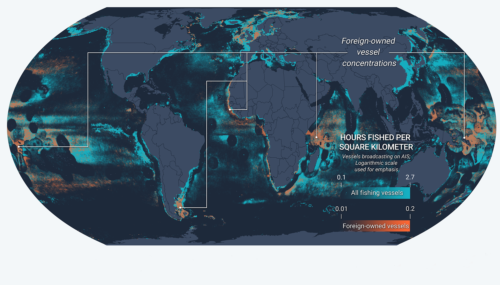It’s been less than two years since we first demonstrated the Global Fishing Watch prototype in public, and the media coverage hasn’t stopped. Since announcing the prototype we’ve been featured in more than 100 publications on six continents, from the Atlantic, the Wall Street Journal and International Business Times to media outlets in Russia, China, France, Argentina, South Africa, Australia and more. The attention is not only exciting, but extremely encouraging.
Our Chief Technology Officer, Paul Woods, puts it this way; “The fact that you have so many people talking about Global Fishing Watch, a product that isn’t even available yet, is an indicator that there is a huge unmet need. There is a need for something that doesn’t exist yet.”
In February, 2016, an article in the New York Times Sunday Magazine opened with a cinematic recounting of one particular day in our offices.
Late on a January 2015 evening in Shepherdstown, W.Va., a data analyst named Bjorn Bergman, surrounded by whiteboards scribbled with computer code, was orchestrating a high-stakes marine police chase halfway around the world.
-Palau vs. the Poachers, NY Times Magazine.
The story, which focused on illegal fishing, went on to describe the coordination of an international effort to track and capture the Shin Jyi Chyuu 33, a vessel we had discovered fishing without permission in the waters off Palau. Other media coverage has included commentary in National Geographic Voices, by conservation technologist and Emerging Explorer Shah Selbe who wrote:
The methods that we traditionally relied upon (to manage marine reserves) can no longer meet these protection needs, so there currently exists a massive demand for new tools and fresh ideas. . . The Global Fishing Watch prototype looks to be a great tool, and a strong step in the right direction when it comes to ocean information.
In a feature article in WIRED, W. Wayt Gibbs wrote:
Large commercial fishers are about to get a new set of overseers: conservationists—and soon the general public—armed with space-based reconnaissance of the global fleet. . . . now environmentalists are using sophisticated technology of their own to peel away that cloak of invisibility.
In addition to filling an unmet need, as Paul described, the global recognition brought to the table by Google and Oceana have helped launch us into the headlines at a time of rising awareness and excitement for protecting our ocean resources. In the past three years alone, high-profile celebrities and philanthropic organizations such as Leonardo DiCaprio, Paul Allen, the Packard Foundation and the Walton Family fund have collectively contributed tens of millions of dollars to ocean conservation and fisheries management.
Political recognition for ocean issues has also gained momentum in recent years. In 2008, the United Nations officially recognized June 8th as World Oceans Day, and in February 2014 President Obama established the world’s largest fully protected marine reserve in the central Pacific Ocean.
“It’s great to see that people agree with us that this is a big deal,” says Paul, noting that it’s more than just a shot in the spotlight. We know what we’re doing is exciting, and we know it’s important, but a part of what’s so valuable about Global Fishing Watch lies in the crowdsourcing capability. Media attention like this is the best recruitment tool for users who are going to help elevate this platform to become one of the most robust resources for monitoring commercial fishing on the world’s oceans.
We’re excited to see that happen.
Below is a brief selection of the many articles that have featured Global Fishing Watch.
2016 (January-April)
Business Wire: Global Fishing Watch Enables Clear View of Fishing in Marine Protected Areas
Yale Environment 360: How Satellites and Big Data Can Help to Save the Oceans
Christian Science Monitor: SkyTruth spots environmental problems from space
Wall Street Journal: Indonesia Takes Explosive Approach to Illegal Fishing
New York Times Sunday Magazine: Palau Vs. the Poachers
2015
National Geographic: Tiny Team Uses Satellites to Bust Illegal Fishing Worldwide
National Geographic:11 Ways Technology Stops Crime Against Endangered Animals
EcoWatch: 15 Huge Ocean Conservation Victories of 2015
The Guardian: To catch a fishing thief, SkyTruth uses data from the air, land and sea
The Huffington Post: Check Out Google’s New Tool for Monitoring Global Fishing
BBC World News Radio Podcast: The Ocean Economy
GovInsider: Open Dataset of the Week: Illegal fishing in Indonesia
Jakarta Post: Government Set to Improve Commercial Fishing Transparency
Fast Company: Inside The Satellite Detective Agencies That Catch The Companies Destroying The Planet—From Space
New York Times: Mapping the World’s Problems
Christian Science Monitor: How to free modern slaves: Three tech solutions that are working
2014
Wall Street Journal: Google, Partners Target Illegal Fishing with New Technology
Wired: The Plan to Map Illegal Fishing from Space “
The Atlantic: Tracking Fishy Behavior from Space
PRI/BCC “The World”: (Radio) Google is teaming up with environmental groups to help fight illegal fishing
CNN: (Video): New Tool Monitors “Pirate” Fishing Boats
CBSN:CBS News: New System to Combat Global Overfishing
Bloomberg: Commercial Fishing Far Out Sea & Over the Horizon – Until Now
Forbes: Google Helps Map Illegal Fishing
Examiner.com: Setting the Watchdogs on Illegal Fishing with Global Fishing Watch
International Business Times: Google-Backed Satellite Project Aims To Track, Eliminate Illegal Fishing Around The World
Maritime Executive: New Google Tool to Track Global Fisheries: Global Fishing Watch provides an unprecedented view of human interaction with the ocean.”

